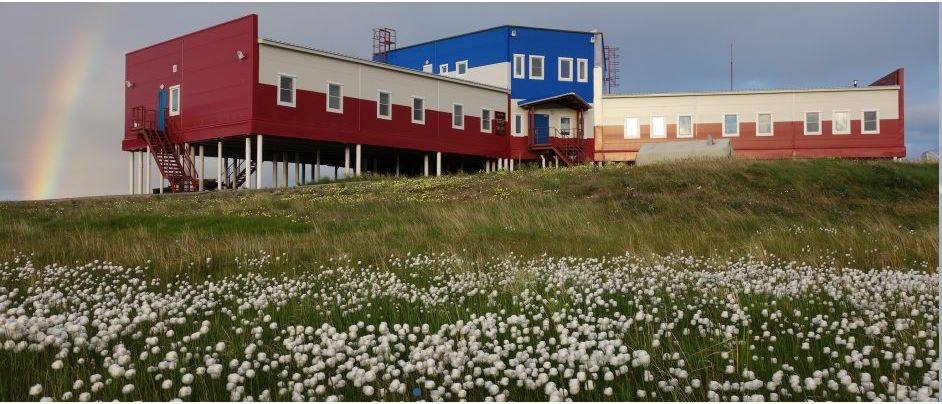In a statement by the Institute of Petroleum Geology and Geophysics, Siberian Branch of the Russian Academy of Sciences (INGG SB RAS), the north magnetic pole of the Earth is shifting towards the Arctic coast of Russia. Year-round observations will soon be conducted at the Samoylov Island Research Station in the delta of the Lena River in Sakha Republic, Russia, on this phenomenon in a specially installed magnetic observatory.
"Scientists believe that it is necessary to conduct research not only in the summer period but to more fully utilize the potential of a year-round station. Year-round measurements will require the organization of a carbon polygon and a magnetic observatory. The latter will make it possible to conduct unique studies of the north magnetic pole, which is currently moving towards the Arctic coast of the Russian Federation," the report says.
INGG SB RAS presented the program for the development of the research station as an international center for integrated research of the Arctic for 2023-2027. To preserve and develop the station, its large-scale renovation, repair, and construction of new facilities for the magnetic observatory are planned.
As previously mentioned experts plan to conduct year-round research at the station, particularly unique studies of the north magnetic pole. Scientists also intend to organize applied research on renewable energy, materials science, and geotechnical monitoring in the Arctic conditions at the Research Station Samoylov Island.
In the program it is specified that INGG SB RAS received a targeted subsidy (RUB 55 million) for the purchase of fuel required for the operation of the Research Station Samoylov Island. This makes it possible to create a stock of fuel and lubricants for the stable operation of the station in the near future. Also, the Ministry of Science and Higher Education of the Russian Federation allocated a subsidy of RUB 5.5 million to replace diesel generator sets on the station.
Further Information on the Samoylov station as put forward in the EU-funded project - International Network for Terrestrial Research and Monitoring in the Arctic - INTERACT:
The Research Station Samoylov Island is owned and run by the Trofimuk Institute of Petroleum Geology and Geophysics, Siberian Branch of the Russian Academy of Sciences.
Location
The Research Station Samoylov Island is located at the southern coast of Samoylov Island in the southern part of the Lena River Delta, Northeast Siberia, close to the Laptev Sea (72°22’ N, 126°29’ E). The Lena River Delta is the largest delta system in the Arctic and Samoylov Island is part of the Lena Delta Reserve, the largest protected area in Russia. The nearest settlement is Tiksi, located about 115 km to the South-East, and home to c. 5000 inhabitants.
Biodiversity and Natural Environment
Samoylov Island is situated in the youngest (Holocene) part of the Lena Delta in the zone of continuous permafrost. It covers an area of about 5 km2 and is dominated by wet polygonal tundra, characterised by low-centered ice-wedge polygons. The regional arctic-continental climate allows maximum thaw depths of about 0.5 m. Grasses (Arctophyla fulva, Dupontia fisherii), hydrophytic sedges such as Carex concolor, Carex chordorrhiza, and Carex rariflora, as well as mosses (e.g. Drepanocladus revolvens, Meesia triquetra, and Aulacomnium palustre) dominate the vegetation in the wet polygon centers and on their edges. Mesophytic dwarf shrubs such as Dryas punctata and Salix reptans, forbs (Saxifraga hirculis), and mosses (Hylocomium splendens, Tomentypnum nitens, Aulacomnium turgidum) dominate the polygon rims.
History and Facilities
The old wooden station was originally built as a logistics base for the Lena Delta Reserve. After its extension in 2005, it became an official Russian-German research station (in 2006), owned and run by the Lena Delta Reserve (Russia) and the Alfred Wegener Institute. In 2013, a new large modern Russian station, owned and run by the Trofimuk Institute of Petroleum Geology and Geophysics, was officially opened and has been working year-round. The old wooden station is still used during the busiest field seasons in summer for additional accommodation and working space. The new station can accommodate up to 25 people. The station building consists of three wings, which include the living areas, scientific laboratories equipped with numerous high-precision instruments, and workshop and storage facilities. The central part includes kitchen and dining room, conference hall, and recreation areas.
General Research and Databases
The field work on Samoylov Island and the Lena Delta aims at studying the evolution of the region’s geology, climate, hydrology, geomorphology, and biology with a special focus on the interaction of the permafrost ecosystems with recent climate warming and its consequences. Several long-term measurement sites for the monitoring of permafrost conditions, micrometeorology, trace gas exchange, and biology are installed on the island and have been providing important data for the expeditions and the research community as a whole since 1998. For more information see Boike, J. et al. 2013: Biogeosciences 10, 2105-2128, https://doi.org/10.5194/bg-10-2105-2013 and Boike, J. et al. 2019 Earth System Science Data, 11, 261–299, https://doi.org/10.5194/essd-11-261-2019. Data and results from Samoylov can be found in the PANGAEA database (www.pangaea.de).
Human Dimension
The human influence on the Lena Delta is minimal due to its status as a nature reserve. There is some subsistence fishing and hunting by indigenous people and occasionally river ships pass by.
Access
The Research Station Samoylov Island can be reached from Tiksi (connected by regular air service to Yakutsk) by helicopter in about 45 minutes and by river boat in about 12 hours. Winter transport is possible by truck or all-terrain vehicle on the ice of the Lena River.
Source:Arctic Century & Interact
Related news:
The Magnetic North Pole has been officially moved
Portals to New Worlds: Martian Exploration Near the North Pole
Portals to New Worlds: Martian Exploration Near the North Pole
The tags below provide an opportunity to view previously posted related news within the selected category


